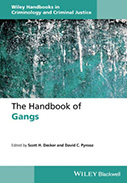The Handbook Of Gangs

Editors: Scott H. Decker and David C. Pyrooz
Publisher: Somerset, NJ: John Wiley & Sons, 2015. 575p.
Reviewer: James C. Howell | July 2017
This large compendium of research on youth and street gangs makes valuable contributions to the field in several areas. Structured much like Ron Huff’s three volume gang state-of-the-art series, Gangs in America, published in 1990, 1996, and 2002, this volume edited by Scott Decker and David Pyrooz is quite comprehensive in its coverage of basic gang research. Outstanding reviews and updates are provided on numerous salient topics, including neighborhood and street gangs, gang joining, the possible existence of gangs as terrorists, gang violence, gang networks, gangs in correctional facilities, gang intelligence databases, female gangs, gang member desistance, and other topics.
In addition, this volume is unique among overviews in criminology for featuring several particularly notable early gang researchers: Malcolm Klein, Irving Spergel, Jim Short, and Walter Miller. While no one in the gang field would dispute the editors’ selection of these leading gang researchers, Ron Huff, Diego Vigil and Joan Moore should have been included. Ron Huff’s (1989) pioneering seven-city Ohio gang studies, followed by others in Denver and Aurora, Colorado and Broward County, Florida demonstrated the utility of self-report surveys of gang members. Across almost three decades, Huff has served as a beacon light in the gang field, particularly with his state-of-the-art handbook series. These salutary accomplishments surely qualify him as a “legacy” in the gang field.
Two other pioneering gang researchers are equally as prominent to those chosen by Decker and Pyrooz. Diego Vigil’s research on Mexican-American gangs filled a major void, and excluding his trailblazing Chicano gang research and leading developmental gang theory is a serious oversight. Equally important, Joan Moore’s (1978, 1991) groundbreaking longitudinal Los Angeles study of female gangs established the seriousness of independent female gangs; and she also led the way in modern-day ethnographic and survey-based studies of female gang involvement. In their defense, perhaps the editors intended to feature only notables from the early generation of gang researchers. Nevertheless, the newer generations of gang researchers have produced an enormous amount of research, and our knowledge base regarding gangs has increased exponentially since that early era of researchers whom Decker and Pyrooz chose to feature.
It should also be noted that the chapter on Walter Miller’s legacy greatly underestimates the national scope of his body of work. Miller stands alone among gang researchers in that findings from his multi-city gang problem studies carried out in the late 1970s and early 1980s led to new federal legislation supporting gang research and program development, and this is a matter of Congressional Record (Howell, 1994; Tatem-Kelley, 1994). Miller’s research reports (1974a, 1974b, 1975, 1992), Congressional testimony (1976), and his subsequent (1990) clarion call for solutions to the growing gang problem in the U.S., prompted Congress to authorize and provide funding for nationwide gang research and program development. In response, the 1992 Amendments to the Juvenile Justice and Delinquency Prevention Act granted new gang research program authority to the federal Office of Juvenile Justice and Delinquency Prevention (OJJDP). Thus, without any doubt, Walter Miller has made a greater contribution to the gang field than any other individual—or university group for that matter.
Under the newly granted program authority, OJJDP embedded gang member studies in three longitudinal juvenile delinquency causes and correlates studies, in Denver, Rochester, and Seattle. Contrary to an assertion in the Handbook, Malcolm Klein had nothing to do with OJJDP’s decision to sponsor this program of research. Rather, the foundation for these longitudinal gang studies was Miller’s multi-city surveys and the legislative authority given to OJJDP to sponsor longitudinal studies of risk factors that led to gang joining in the three cities (Howell, 1994). Miller’s pioneering multi-city survey methodology also led to the nationally representative youth gang survey, and to the establishment of a National Youth Gang Center, later renamed the National Gang Center.
Three other limitations of this Handbook are apparent. First, none of the chapters provides comprehensive trend data on the prevalence of gang problems in cities and counties across the United States. Valid, reliable, and widely published nationwide trend data from the National Youth Gang Survey cover nearly two decades from 1995 forward (Egley, Howell, & Harris, 2014; Howell & Griffiths, 2016).
Second, this Handbook should have devoted a chapter to what works in preventing gang involvement and reducing gang crime. Relying largely on an outdated review of gang programs that was published more than a decade ago (Klein & Maxson, 2006), the Handbook perpetuates the misleading notion that anti-gang programming in the U.S. is unproven or at best merely promising. Presently, at least a dozen gang programs have been proven effective by traditional scientific standards. For rigorous systematic reviews, readers are invited to see Hodgkinson, Marshall, Berry et al.’s (2009) meta-analysis of comprehensive community programs; Braga and Weisburd’s (2012) meta-analysis of deterrence-based strategies; and Howell & Griffiths (2016) review of effective gang programs. Because gangs are commonly institutionalized in large American cities and gang members are often embedded in established gangs, it would in my judgment be unrealistic to expect highly effective outcomes.
Third, inexplicably, the Handbook chapter authors in several instances call for a developmental theory of gang joining. Five prominent developmental models below should have been discussed.
- Vigil’s (1988) multiple marginality theory captures the process through which young people are left out of mainstream society because of language, education, cultural, and economic barriers in schools, neighborhoods, and communities. These forces contribute to the breakdown of social control and the emergence of gangs and gang members (Conchas & Vigil, 2012).
- The Seattle Social Development Model of gang involvement (Hill, Howell, Hawkins, & Catalano, 1999) articulates the mechanisms of socialization and identifies parallel but separate paths for prosocial and antisocial processes consisting of opportunities for involvement, actual involvement, skills, rewards, bonding, and adoption of beliefs.
- The interactional model (Thornberry & Krohn, 2005) specifies the several interacting domains that account for life course patterns of gang career onset, course length and shape, and desistance, and that the various risk factors are more influential at different developmental stages in childhood and adolescence.
- The multi-stage developmental gang model of gang joining (Howell & Egley, 2005; Raby & Jones, 2016) identifies risk factors in multiple developmental domains across four age-graded periods—the preschool, school entry, late childhood, early adolescence and late adolescence.
- The life course model (Melde & Esbensen, 2011) highlights turning points through life, specifically the enhancement effect of gang membership on deviant behavior from a life-course framework.
To summarize, despite several notable shortcomings with respect to the history of gang research, gang problem trends, effective programs, and recent developmental theory advancements, this handbook is a valuable resource as an overview of the state-of-the-art of basic gang research. The most egregious shortcomings of this volume are that, first, Walter Miller’s contributions to the gang field were grossly understated; second, it neither documents the scope nor seriousness of the U.S. gang problem; and third, it fails to inform readers about evidence-based solutions.
References
Braga, A. A., & Weisburd, D. L. (2012). The effects of focused deterrence strategies on crime: A systematic review and meta-analysis of the empirical evidence. Journal of Research in Crime and Delinquency, 49, 323–358.
Conchas, G. Q. & Vigil, J. D. (2010). Multiple marginality and urban education: Community and school socialization among low-income Mexican-descent youth. Journal of Education for Students Placed at Risk, 15, 51-65.
Egley, A. Jr., Howell, J. C., & Harris, M. (2014). Highlights of the 2012 National Youth Gang Survey. Washington, DC: U.S. Department of Justice, Office of Juvenile Justice and Delinquency Prevention.
Hill, K. G., Howell, J. C., Hawkins, J. D., & Battin-Pearson, S. R. (1999). Childhood risk factors for adolescent gang membership: Results from the Seattle Social Development Project. Journal of Research in Crime and Delinquency, 36, 300-322.
Hodgkinson, J., Marshall, S., Berry, G., Reynolds, P., Newman, M., Burton, E., Dickson, K., & Anderson, J. (2009). Reducing Gang-Related Crime: A Systematic Review of “Comprehensive” Interventions: Summary Report. London: EPPI-Centre, Social Science Research Unit, Institute of Education, University of London.
Howell, J. C. (1994). Recent gang research: Program and policy implications. Crime and Delinquency, 40, 495-515.
Howell, J. C., & Egley, A., Jr. (2005). Moving risk factors into developmental theories of gang membership. Youth Violence and Juvenile Justice, 3, 334–354.
Howell, J. C., & Griffiths, E. (2016). Gangs in America’s Communities (2nd Ed.). Thousand Oaks, CA: Sage Publications. [The third edition will be published in 2018.]
Huff, C. R. (1989). Youth gangs and public policy. Crime and Delinquency, 35, 524-537.
Huff, C. R. (Ed.). (1990). Gangs in America. Thousand Oaks, CA: Sage.
Huff, C. R. (Ed.). (1996). Gangs in America (2nd ed.). Thousand Oaks, CA: Sage.
Huff, C. R. (2002). Gangs in America III. Thousand Oaks, CA: Sage.
Klein, M. W., & Maxson, C. L. (2006). Street Gang Patterns and Policies. New York, NY: Oxford University Press.
Melde, C., & Esbensen, F. (2011). Gang membership as a turning point in the life course. Criminology, 49, 513-552.
Miller, W. B. (1974a). American youth gangs: Fact and fantasy. In L. Rainwater (Ed.), Deviance and Liberty: A Survey of Modern Perspectives on Deviant Behavior (pp. 262–273). Chicago: Aldine.
Miller, W. B. (1974b). American youth gangs: Past and present. In A. Blumberg (Ed.), Current Perspectives on Criminal Behavior (pp. 210–239). New York: Knopf.
Miller, W. B. (1975). Violence by Youth Gangs and Youth Groups as a Crime Problem in Major American Cities. Washington, DC: U.S. Department of Justice, Office of Juvenile Justice and Delinquency Prevention.
Miller, W. B. (1976). New federal initiatives re serious collective youth crime. In Hearings before the Subcommittee to Investigate Juvenile Delinquency of the Committee on the Judiciary (262-266). U.S. Senate, 95th Cong.2d Ses. April 10 and 12.
Miller, W. B. (1990). Why the United States has failed to solve its youth gang problem. In C.R. Huff (Ed.). Gangs in America (pp. 263-287). Newbury Park, CA: Sage.
Miller, W. B. (1992). Crime by Youth Gangs and Groups in the United States. Washington, DC: U.S. Department of Justice, Office of Juvenile Justice and Delinquency Prevention.
Moore, J. W. (1978). Homeboys: Gangs, Drugs and Prison in the Barrios of Los Angeles. Philadelphia: Temple University Press.
Moore, J. W. (1991). Going Down to the Barrio: Homeboys and Homegirls in Change. Philadelphia: Temple University Press.
Raby, C., & Jones, F. (2016). Identifying risks for male street gang affiliation: A systematic review and narrative synthesis. The Journal of Forensic Psychiatry & Psychology, DOI: 10.1080/14789949.2016.1195005
Tatem-Kelley, B. (1994). A Comprehensive Strategy to Address America’s Gang Problem. Washington, D.C.: Office of Juvenile Justice and Delinquency Prevention, U.S. Department of Justice.
Thornberry, T. P., & Krohn, M. D. (2005). Applying interactional theory to the explanation of continuity and change in antisocial behavior. In D.P. Farrington (Ed.). Integrated Developmental and Life-Course Theories of Offending (pp. 183-210). New Brunswick, NJ: Transaction Publishers.
Vigil, J. D. (1988). Barrio Gangs: Street Life and Identity in Southern California. Austin: University of Texas Press.
James C. Howell is formerly Director, Research and Program Development, Office of Juvenile Justice and Delinquency Prevention, U.S. Department of Justice.


